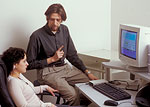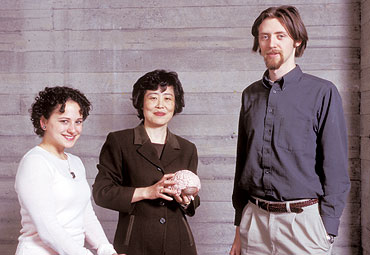Catching the Wave of Biofeedback Research
Open gallery

A 20-something student settles into a plush brown recliner. The room is small and quiet, with beige walls and sparse decoration. For the next 45 minutes, the student’s only task will be to move the image of a balloon around a computer screen in front of her. But she won’t be using a mouse, or a keyboard, or even a joystick. She’ll simply be using the power of her mind.
A handful of students participated in similar sessions this summer as part of a student-faculty research study led by Yueping Zhang, assistant professor of psychology, and students Gary Howarth ’06 and Julianne Muto ’05. The goal: to explore whether people can learn to control their brain waves.
“Our project is designed to show whether EEG [electroencephalogram] biofeedback training can improve cognitive function,” Zhang says. “We’re focusing on memory, attention, and indicators of self-reported well-being, such as the ability to sleep and concentrate.”
EEG biofeedback training theorizes that a simple reward system can teach people to self-regulate their brain activity. Suppose, for example, that researchers electronically tie a particular brain-wave frequency to a visual or aural effect, such as a musical note. Whenever a research participant achieves the desired brain-wave frequency, the note will sound. EEG biofeedback training posits that the participant can learn how to achieve that frequency by learning how to make the note play.

Julianne Muto ’05, Yueping Zhang, assistant professor of psychology, and Gary Howarth ’06.
The idea could have many applications, but the one that most interests Zhang, Howarth, and Muto is the potential for alternative treatment in clinical psychology. If effective, EEG biofeedback could radically change treatment options for everything from attention deficit disorder to substance abuse.
“Developing alternatives to medication is important,” Muto says. “EEG has the potential to be a progressive tool in the treatment of psychological disorders.”
Anecdotal evidence suggests that EEG biofeedback training has indeed helped thousands of patients. However, exploration of the field has been limited primarily to observational case studies or studies that have lacked placebo or control groups. Thus, Zhang, Howarth, and Muto designed a study that would go beyond clinical accounts to examine the matter scientifically.
After winning grants from the College’s Faculty-Student Research Fund and the Student Academic Affairs Board, the researchers enlisted about 15 Lewis & Clark summer-school students to participate in the study. Participants first went through an initial assessment of memory, attention, and anxiety. Then, over the next several weeks, a subgroup of participants underwent five sessions of EEG biofeedback training.
During these sessions, each student relaxed in a private room that contained a computer and an easy chair. Electrodes —two behind the ears and one on top of the student’s head—connected the par-ticipant to an EEG machine that measured his or her brain-wave activity. By attaining a desirable ratio of alpha waves (typically present in an awake but relaxed mental state) and beta waves (typically present during alert, active thinking), students were able to move a balloon image around the computer screen. As participants improved their ability to manipulate the image, the research team adjusted the threshold alpha/beta levels for greater challenge and to encourage continued progress.
Finally, after the five training sessions were completed, the researchers reassessed participants’ memory, attention, and anxiety levels.
Initial analysis of the data has bolstered the idea that EEG biofeedback can improve brain function. By the end of the study period, students who received biofeedback training showed improved memory and concentration, more ease in falling asleep, better sleep continuity, and significant improvement in mental relaxation. These trends differed markedly from the results of both a control group that did not attend training sessions and a placebo group that received random feedback during training sessions.
“So far, we’re encouraged because we’re seeing movement in the directions we predicted,” Howarth says. “We’re beginning to show a trend, and that’s positive for the future.”
Zhang and her students are analyzing data they collected during summer and fall terms, with the hope of presenting their research at the Western psychological Association’s convention in Portland later this spring.
Involvement in the project also has helped shape the researchers’ other work and future directions. To strengthen the study, Zhang plans to aggregate the Lewis & Clark data with data from a similar project she directed while an assistant professor at DePauw University. This fall, Muto applied her EEG analysis skills to a research project that considered whether yoga practice affects stress and attention levels (see related article at right). And both Howarth and Muto say the experience will help with their plans to pursue graduate study.
“This study has given me a much better idea of how to conduct research,” Howarth says. “I feel especially fortunate to have been involved from conception all the way through to presentation. The experience has been invaluable.”
EEG Research Expands to Yoga, Video Gamers
Can regular yoga practice affect our brain activity and aid relaxation? Do video-game players have quicker reflexes than the rest of us? Last fall, Lewis & Clark students and Yueping Zhang, assistant professor of psychology, designed research studies to answer these questions.
The yoga study is among the first of its kind to use electroencephalogram (EEG) readings to test whether doing yoga affects stress and attention levels. The study was designed to show whether students in a college yoga class experienced changes in their brain-wave patterns over the semester and whether these students had different brain-wave patterns than the general student population. Julianne Muto ’05, who led the study with fellow psychology major Nicholas Bookman ‘05, got the idea to add an EEG dimension after helping conduct an EEG biofeedback project last summer (see article at left).
The same summer project played an even more direct role in spawning research on video-game players and response times. During the summer biofeedback study, student and faculty researchers noticed that some participants were reacting surprisingly quickly to stimuli on an attention test—so quickly, in fact, that the computerized test was unable to categorize some of their responses correctly.
This observation led the researchers to hypothesize that a history of heavy technology use may have improved participants’ reaction times. Soon biology major Anne Chamberlin ‘05 and psychology major Nolan Nichols ‘05 embarked on a study to compare response times of members of a Lewis & Clark video-gamers club with those of other Lewis & Clark students.
The researchers collected data over fall semester and are now analyzing the results. If all goes well, they could be presenting all three studies at the Western Psychological Association’s convention in Portland this April.
by Amelie Welden ’97
More L&C Magazine Stories
Lewis & Clark Magazine is located in McAfee on the Undergraduate Campus.
MSC: 19
email magazine@lclark.edu
voice 503-768-7970
fax 503-768-7969
The L&C Magazine staff welcomes letters and emails from readers about topics covered in the magazine. Correspondence must include your name and location and may be edited.
Lewis & Clark Magazine
Lewis & Clark
615 S. Palatine Hill Road MSC 19
Portland OR 97219

